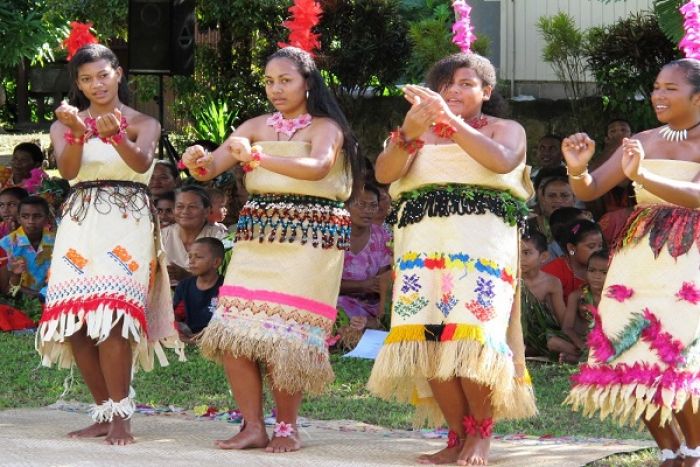Culture, Traditions and People Featured
 Young Girls performing Tongan Tau'olunga (dance) at Sawana, near Lomolomo, Vanua Balavu
Young Girls performing Tongan Tau'olunga (dance) at Sawana, near Lomolomo, Vanua Balavu
CULTURE, TRADITIONS AND PEOPLE
by: Viliame Ravai
The sound of the waves is constant. The wind does change directions sometimes. It mostly comes in though from the direction of Tonga towards the east. As the sun bites into the sandy tracks at Vanuabalavu, you can't help it but be taken in by a sense of appreciation of nature.
Life on Vanuabalavu is almost a mix of two different cultures and traditions. It is difficult not to notice the heavy influence of Tongan culture and tradition on the lifestyle of the people of Vanuabalavu.
Against this historic and traditional setting, life continues as normal for the people of this island. History tells us of Ma'afu's influence in Fiji which remained a constant threat for Ratu Cakobau who had to rely on white settlers and their guns to wage wars against other parts of Fiji and maintain his supremacy.
The history books tell us that from 1848 to 1874, Ma'afu waged wars and protected teachers and missionaries supported by his two lieutenants Semisi Fifita and Wainiqolo.
He maintained his claim, however, to be the overseer of the Tongan population, and when the Tui Nayau raised the Tongan flag over Lakeba, Ma'afu reportedly took control of the Lau archipelago on the basis that its paramount chief had declared it a Tongan territory.
But reports suggest Ma'afu was faced with a crisis in June 1868, when the Tongan government disclaimed all sovereignty over Fijian territory, including the Lau Islands.
That was when Ma'afu could no longer exercise authority over Lau as a Tongan prince. Lauan chiefs were said to have met at Lakeba on February 1869, and granted Ma'afu the title of Tui Lau, or King of Lau.
He was subsequently recognised as such by the chiefs of Cakaudrove and Bua in May 1869, but reportedly abdicated in favour of Cakobau and the united Fijian monarchy in 1871. Ma'afu later played a leading role in the cession of Fiji to the United Kingdom in 1874.
The important link between Vanuabalavu and Tonga was further strengthened on May 6, 1990, when the Queen of Tonga and her son King Tupou V visited Sawana with the late Tui Nayau and former president of Fiji, Ratu Sir Kamisese Mara to celebrate his 70th birthday and to pay homage to the people of Sawana and Loto'a as the home base of Ma'afu.
Ma'afu is well known and written about in our history. He reportedly opted for Sawana, Lomaloma on Vanuabalavu as his base and the headquarters of the new chiefdom of Lau combining Yasayasa Moala, Lau and Somosomo Group under his command.
Sure, there were descendants of warriors who supported Ma'afu. There are links back to Vavau, Haapai and Tongatapu firmly embedded on Vanuabalavu. The people of Vanuabalavu are different from other islanders in the Lau Group maybe because of the influence of the Yavusa Toga there.
You can see it in their faces, especially at Sawana. The Polynesian look is quite strong. Then there is the long dark hair and fair skin. The difference stretches through to the way they dress. And there is the language, and heavy influence of Tongan words intermingled with iTaukei words.
You can't help it but be attracted by the fact that they speak the Tongan language fluently. As I was from Viti Levu they showed their Tongan way of greeting. There were the many "malo!" greetings and pecks on the cheek.
You can't escape the friendliness of the people of Vanuabalavu. In church, the service was in Tongan. The talatala delivered his sermon in that language. I'd sat right at the back as I did not understand a word spoken.
I'd also noticed the traditional tawala worn as part of their attire for special occasions. The tawala is a very fine mat Tongans tie around their waist. The women in the village have to wear different tawala from the men.
I discovered that the colour of the tawala also represents the background of the person wearing it. So if you wear a brown tawala if someone passed away, that means you are of a lower rank than the deceased.
Different tawala have different meanings, I was told, like the tawala that is specially made for a meke for instance. It is easy to notice someone on Vanuabalavu of Tongan origin.
They have fair skin, black hair and there is a distinctive accent. At Sawana, I also noticed the way they participate in ceremonies. There is a healthy appetite evident during festivities.
Over the festive season, the table brimmed with fruits, vegetables, pork, beef and fish. There was even some goat meat. But getting to Vanuabalavu isn't easy. You've got to stand the long journey by sea, well over 24 hours of travelling.
And if you are still game for some exciting times on the island, then you've also got to prepare yourself to spend time there as vessels making the trip to Vanuabalavu can sometimes arrive late or be delayed.
The beauty of Vanuabalavu is to be appreciated though, especially when one does get to Qilaqila or the Bay of Islands on the northern edge. Sitting to the north-east of Suva, Vanuabalavu is an island that has managed to retain its historic links with Tonga.
Culture and tradition are important facets of the lives of the people of Vanuabalavu. They hold them close to their hearts. They value and treasure them. And that's what makes it a special place to visit.
The Fiji Times Online

